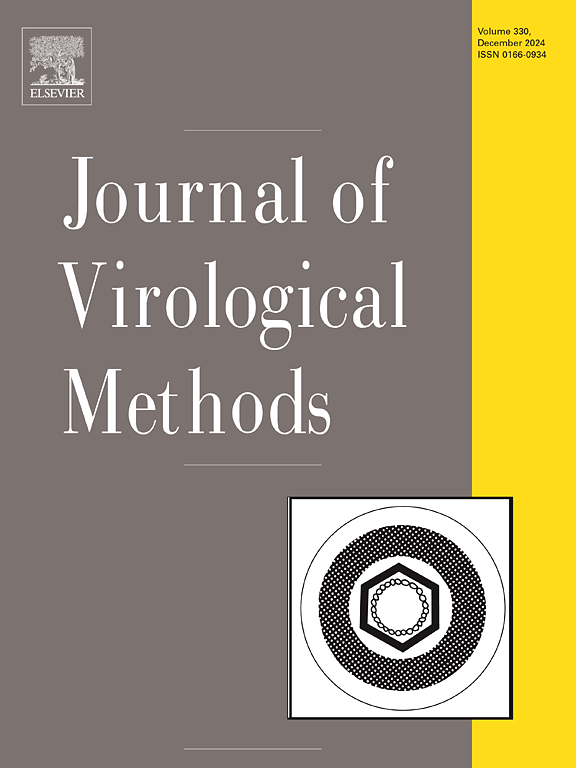开发一种等位基因特异性定量聚合酶链反应测定法,用于区分 RLB 106 株和牛 Varicellovirus bovinealpha1 的野生型病毒。
IF 1.6
4区 医学
Q3 BIOCHEMICAL RESEARCH METHODS
引用次数: 0
摘要
牛水痘病毒1 (BoAHV1)是引起牛呼吸道和生殖疾病等多种病理状况的重要病原体。含有温度敏感突变RLB 106株的鼻内疫苗用于控制boahv1相关疾病。为了监测BoAHV1野生型病毒在接种人群中的入侵情况,有必要开发一种简单的方法来区分RLB 106株和BoAHV1野生型病毒。在这项研究中,我们建立了一种针对UL40点突变G23136A的等位基因特异性定量聚合酶链反应(AS-qPCR)检测RLB 106菌株。我们使用每个点突变位点靶向引物组计算了从配对qPCR获得的Cq值的差异(ΔCq),并建立了分化的截断ΔCq。UL40的DNA部分测序证实了分化的准确性。结果表明,as - qpcr分化结果与DNA测序结果一致,田间分离菌株RLB 106表现出温度敏感表型。因此,本研究建立的AS-qPCR方法有望在一步反应中实现RLB 106株与野生型病毒的简单区分。本文章由计算机程序翻译,如有差异,请以英文原文为准。
Development of an allele-specific quantitative polymerase chain reaction assay for differentiating the RLB 106 strain from the wild-type viruses of Varicellovirus bovinealpha1
Varicellovirus bovinealpha1 (BoAHV1) is an important causal agent of various pathological conditions, such as respiratory and reproductive diseases, in cattle. An intranasal vaccine containing a temperature-sensitive mutant RLB 106 strain is used to control BoAHV1-related diseases. To monitor the invasion of BoAHV1 wild-type viruses in vaccinated populations, it is essential to develop a simple method for differentiating between the RLB 106 strain and BoAHV1 wild-type viruses. In this study, we developed an allele-specific quantitative polymerase chain reaction (AS-qPCR) assay that targets the point mutation G23136A located in UL40 for detecting the RLB 106 strain. We calculated the difference in Cq values (ΔCq) obtained from a paired qPCR using each point mutation site-targeting primer set and established the cutoff ΔCq for differentiation. The accuracy of differentiation was confirmed by the DNA partial sequencing of UL40. Results demonstrated that differentiation by AS-qPCR was consistent with the results obtained by DNA sequencing, and the field isolates classified as the RLB 106 strain exhibited a temperature-sensitive phenotype. Hence, the AS-qPCR assay developed in this study could be a promising method for the simple differentiation between the RLB 106 strain and wild-type viruses in a single-step reaction.
求助全文
通过发布文献求助,成功后即可免费获取论文全文。
去求助
来源期刊
CiteScore
5.80
自引率
0.00%
发文量
209
审稿时长
41 days
期刊介绍:
The Journal of Virological Methods focuses on original, high quality research papers that describe novel and comprehensively tested methods which enhance human, animal, plant, bacterial or environmental virology and prions research and discovery.
The methods may include, but not limited to, the study of:
Viral components and morphology-
Virus isolation, propagation and development of viral vectors-
Viral pathogenesis, oncogenesis, vaccines and antivirals-
Virus replication, host-pathogen interactions and responses-
Virus transmission, prevention, control and treatment-
Viral metagenomics and virome-
Virus ecology, adaption and evolution-
Applied virology such as nanotechnology-
Viral diagnosis with novelty and comprehensive evaluation.
We seek articles, systematic reviews, meta-analyses and laboratory protocols that include comprehensive technical details with statistical confirmations that provide validations against current best practice, international standards or quality assurance programs and which advance knowledge in virology leading to improved medical, veterinary or agricultural practices and management.

 求助内容:
求助内容: 应助结果提醒方式:
应助结果提醒方式:


